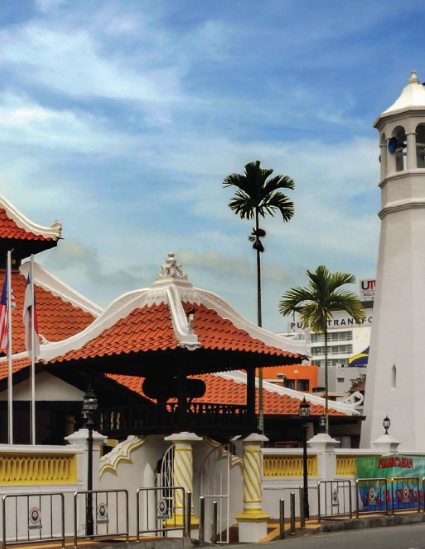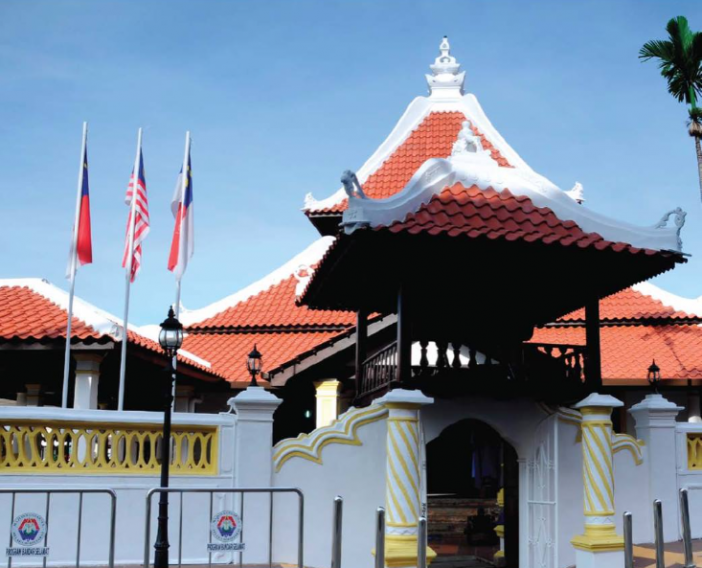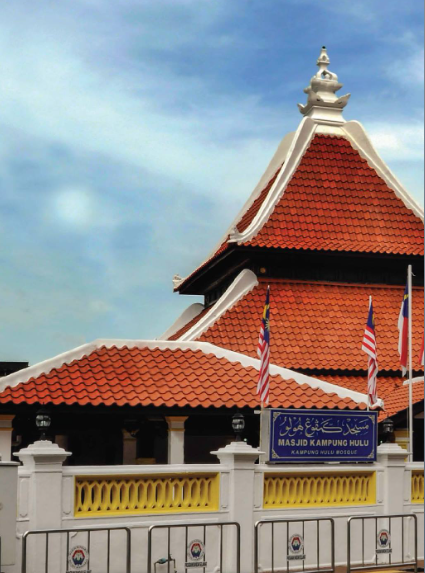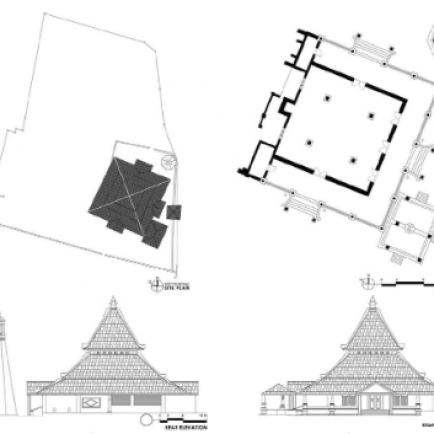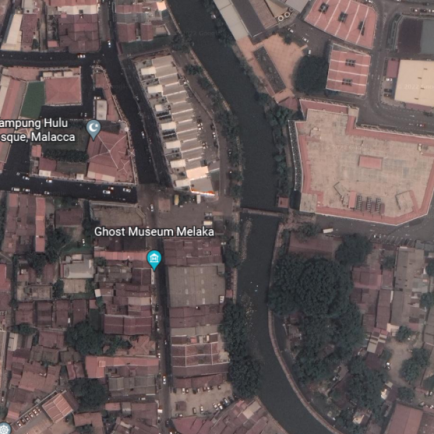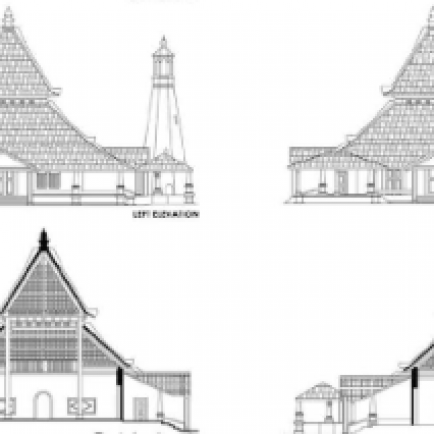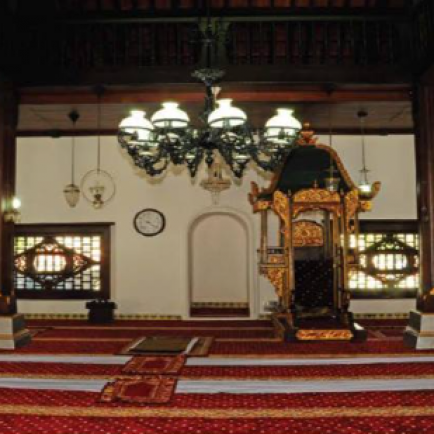Kampung Hulu Mosque
History
Masjid Kampung Hulu, built in 1141 Hijri year, which is equivalent to the year 1728, is a historical and unique mosque. The mosque was built during the Dutch rule of Melaka from 1641 to 1825. It is believed to have been built by a Chinese Muslim by the name of Datuk Haji Shamsuddin in the 18th century. He bore all the expenses and was also the architect of this mosque. The mosque is located in Kampung Hulu, a fishing village near the Melaka River.
Urban and Architectural
The design concept of Kampung Hulu mosque symbolises the concept of God and nature. The concept of God and the Malay realm was said to be extracted from the lotus flower, the basis of many other symbols. The lotus flower is considered to be part of the symbol of Malay culture which had its beginnings from Hindu and Buddhist beliefs as this area was once ruled by a Kingdom that had embraced both religions. There are two parts to the concept of the mosque, which was applied to the overall design of the mosque. The divine (God) level is called Pasu Kubah and it consists of three levels, which are the ahadiat level (hakikat), wahdah level and wahidiah level. The fifth level is said to represent nature starting from the base to the roof of the mosque. The overall concept of the mosque is described as one’s ‘Journey to God’. The first, second and the third ridges represent the syariat level while the penunjuk langit pointing upwards represents the tariqat level.
The main prayer hall of this mosque measures 12×12 metres (39 x 39 feet). At the main prayer hall there are four columns made of belian wood measuring 225 x 225 mm (8.8 x 8.8 inches) known as soko guru. These four columns support the entire roof tiers. At the centre of these four columns is where the tunjuk langit is placed, and the carvings on it are called buah butun. The middle section is also the second roof layer. Here, connecting support beams from the four columns are placed onto the masonry walls for additional support.
The mihrab is located at the very front and faces the qibla. The mihrab of this mosque measures 1 x 1.5 metre (3 x 4.9 feet) and is only for the Imam to stand to lead any congregation prayers. On the right of the mihrab, is an ornately-carved minbar used by the imam or khatib to deliver a sermon. The wing- shaped carvings are influenced by Javanese architecture. Inside the minbar are carvings of roses and cloud motifs and it serves as a backrest for the Imam or khatib. This mosque also has a minaret, which was once used for azan, the call for daily prayers. The ablutions area is located at the front of the mosque facing the qibla.
Description
Kampung Hulu Mosque is a mosque situated at Kampong Hulu Village in Malacca City, Malacca, Malaysia. It is the oldest mosque in Malacca and among the oldest in the country. An ancient cemetery lies next to the mosque in where some notable preachers and missionaries are buried
References
https://en.wikipedia.org/wiki/Kampung_Hulu_Mosque
https://itc.gov.my/listings/masjid-kampung-hulu-bandaraya-melaka/
Aziz, A. A., 2016. MASJID - Selected Mosques and Musollas in Malaysia, ATSA Architects Sdn. Bhd.
Details
Location
Jalan Kampung Hulu, Kampung Dua, 75200 Melaka, Malaysia
Worshippers
500
Owners
Datuk Haji Shamsuddin
Architect Name
Year of Build
1728
Area
4000 m2
Drawings
Map
History
Masjid Kampung Hulu, built in 1141 Hijri year, which is equivalent to the year 1728, is a historical and unique mosque. The mosque was built during the Dutch rule of Melaka from 1641 to 1825. It is believed to have been built by a Chinese Muslim by the name of Datuk Haji Shamsuddin in the 18th century. He bore all the expenses and was also the architect of this mosque. The mosque is located in Kampung Hulu, a fishing village near the Melaka River.
Urban and Architectural
The design concept of Kampung Hulu mosque symbolises the concept of God and nature. The concept of God and the Malay realm was said to be extracted from the lotus flower, the basis of many other symbols. The lotus flower is considered to be part of the symbol of Malay culture which had its beginnings from Hindu and Buddhist beliefs as this area was once ruled by a Kingdom that had embraced both religions. There are two parts to the concept of the mosque, which was applied to the overall design of the mosque. The divine (God) level is called Pasu Kubah and it consists of three levels, which are the ahadiat level (hakikat), wahdah level and wahidiah level. The fifth level is said to represent nature starting from the base to the roof of the mosque. The overall concept of the mosque is described as one’s ‘Journey to God’. The first, second and the third ridges represent the syariat level while the penunjuk langit pointing upwards represents the tariqat level.
The main prayer hall of this mosque measures 12×12 metres (39 x 39 feet). At the main prayer hall there are four columns made of belian wood measuring 225 x 225 mm (8.8 x 8.8 inches) known as soko guru. These four columns support the entire roof tiers. At the centre of these four columns is where the tunjuk langit is placed, and the carvings on it are called buah butun. The middle section is also the second roof layer. Here, connecting support beams from the four columns are placed onto the masonry walls for additional support.
The mihrab is located at the very front and faces the qibla. The mihrab of this mosque measures 1 x 1.5 metre (3 x 4.9 feet) and is only for the Imam to stand to lead any congregation prayers. On the right of the mihrab, is an ornately-carved minbar used by the imam or khatib to deliver a sermon. The wing- shaped carvings are influenced by Javanese architecture. Inside the minbar are carvings of roses and cloud motifs and it serves as a backrest for the Imam or khatib. This mosque also has a minaret, which was once used for azan, the call for daily prayers. The ablutions area is located at the front of the mosque facing the qibla.
Description
Kampung Hulu Mosque is a mosque situated at Kampong Hulu Village in Malacca City, Malacca, Malaysia. It is the oldest mosque in Malacca and among the oldest in the country. An ancient cemetery lies next to the mosque in where some notable preachers and missionaries are buried


